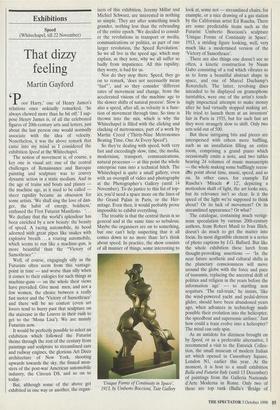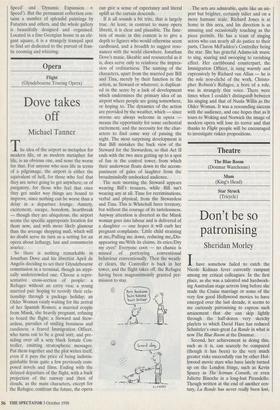Exhibitions
Speed (Whitechapel, till 22 November)
That dizzy feeling
Martin Gaylord
Poor Harry,' one of Henry James's relations once unkindly remarked, 'he always chewed more than he bit off.' I sup- pose Henry James is, of all the celebrated figures of 20th-century arts and letters, just about the last person one would normally associate with the idea of velocity. Nonetheless, it was the above remark that came into my mind as I considered the exhibition Speed at the Whitechapel.
The notion of movement is, of course, a key one in visual art: one of the central challenges of Renaissance and Baroque painting and sculpture was to convey dynamic action in a static medium. And in the age of trains and boats and planes the machine age, as it used to be called sheer rapidity became an obsession for some artists. 'We shall sing the love of dan- ger, the habit of energy, boldness,' enthused the First Futurist Manifesto. `... We declare that the world's splendour has been enriched by a new beauty: the beauty of speed. A racing automobile, its hood adorned with great pipes like snakes with explosive breath ... a roaring automobile, which seems to run like a machine-gun, is more beautiful than the "Victory of Samothrace".'
Well, of course, engagingly silly as the Futurists often seem from this vantage- point in time — and worse than silly when it comes to their eulogies for such things as machine-guns — on the whole their views have prevailed. Give most men, and not a few women, the choice between a really fast motor and the 'Victory of Samothrace' and there will be no contest (even art lovers tend to hurry past that sculpture on the staircase in the Louvre in their rush to get to the 'Mona Lisa'). We are mainly Futurists now.
It would be perfectly possible to select an exhibition which followed the Futurist theme through the rest of the century from paintings and sculpture to streamlined cars and railway engines, the glorious Art Deco architecture of New York, shooting upwards towards the sky, the finned mon- sters of the post-war American automobile industry, the Citroen DS, and so on to today. But, although some of the above get exhibited in one way or another, the organ- isers of this exhibition, Jeremy Millar and Michiel Schwarz, are interested in nothing so simple. They are after something much grander, nothing less than the rebranding of the entire epoch. 'We decided to consid- er the revolutions in transport or media, communications or politics, as part of one larger revolution, the Speed Revolution.' So we all live in the speed age, which may explain, as they note, why we all suffer so badly from impatience. All this rapidity, they worry, is bad for us.
Nor do they stop there. Speed, they go on to remark, 'does not necessarily mean "fast" ', and so they consider 'different rates of movement and change, from the accelerated visions of the machine age to the slower shifts of natural process'. Slow is also a speed, after all, as velocity is a func- tion of movement through time. So time is thrown into the mix, which is why the Whitechapel is filled with the clicking and clacking of metronomes, part of a work by Martin Creed (`Thirty-Nine Metronomes Beating Time, One At Every Speed').
So they're dealing with speed, both very fast and exceedingly slow, time, the media, modernism, transport, communications, natural processes — at this point the whole enterprise runs into a technical hitch. The Whitechapel is quite a small gallery, even with an overspill of video and photography at the Photographer's Gallery (until 14 November). To do justice to this list of top- ics, you'd need a space more on the lines of the Grand Palais in Paris, or the Her- mitage. Even then, it would probably prove impossible to exhibit everything.
The trouble is that the central thesis is so general and at the same time so nebulous. Maybe the organisers are on to something, but one can't help suspecting that it all comes down to no more than: let's think about speed. In practice, the show consists of all manner of things, some interesting to `Unique Forms of Continuity in Space, 1913, by Umberto Boccioni, Tate Gallery look at, some not — streamlined chairs, for example, or a nice drawing of a gas station by the Californian artist Ed Ruscha. There are some predictable items such as the Futurist Umberto Boccioni's sculpture `Unique Forms of Continuity in Space', 1913, a striding figure looking, well, very much like a modernised version of the `Victory of Samothrace'.
There are also things one doesn't see so often, a kinetic construction by Naum Gabo consisting of a rod which vibrates so as to form a beautiful abstract shape in space, and one of Marcel Duchamp's Rotoreliefs. The latter, revolving discs intended to be displayed on gramophone turntables, were one of the artist's touch- ingly impractical attempts to make money after he had virtually stopped making art. He tried to launch them at an inventors' fair in Paris in 1935, but for such fast art they were strangely slow to shift. Only two sets sold out of 500.
But these intriguing bits and pieces are interspersed with others more baffling, such as an installation filling an entire room, comprising a grand piano which occasionally emits a note, and two tables bearing 24 volumes of music manuscripts — the whole making some bafflingly recon- dite point about time, music, speed, and so on. In other cases, for example Ed Ruscha's 'Miracle # 12', depicting a motionless shaft of light, the art looks nice, but its relevance isn't so clear. Is it the speed of the light we're supposed to think about? Or its lack of movement? Or its streamlined appearance? Or what?
The catalogue, containing much vertigi- nous speculation by various 20th-century authors, from Robert Musil to Ivan Illich, doesn't do much to get the matter into focus. Its most digestible element is a series of photo captions by J.G. Ballard. But like the whole exhibition these lurch from thought-provoking assertions — 'In the near future aesthetic and cultural shifts in the planetary consciousness will move around the globe with the force and pace of tsunamis, replacing the ancestral drift of politics and religion in the years before the information age' — to startling non sequiturs. 'The rail-train,' he insists, 'like the wind-powered yacht and pedal-driven glider, should have been abandoned years ago, when advances in technology made possible their evolution into the helicopter, the speedboat and supersonic airliner.' Just how could a train evolve into a helicopter? The mind can only spin.
As an antidote for dizziness brought on by Speed, or as a preferable alternative, I recommend a visit to the Estorick Collec- tion, the small museum of modem Italian art which opened in Canonbury Square, London N1, earlier this year. At the moment, it is host to a small exhibition Balla and Futurist Italy (until 13 December) of paintings from the Galleria Nazionale d'Arte Moderna in Rome. Only two of these are top rank (Balla's 'Bridge of Speed' and 'Dynamic Expansion + Speed'). But the permanent collection con- tains a number of splendid paintings by Futurists and others, and the whole gallery is beautifully designed and organised. Located in a fine Georgian house in an ele- gant square, it is a strangely tranquil spot to find art dedicated to the pursuit of fran- tic zooming and whizzing.











































































 Previous page
Previous page